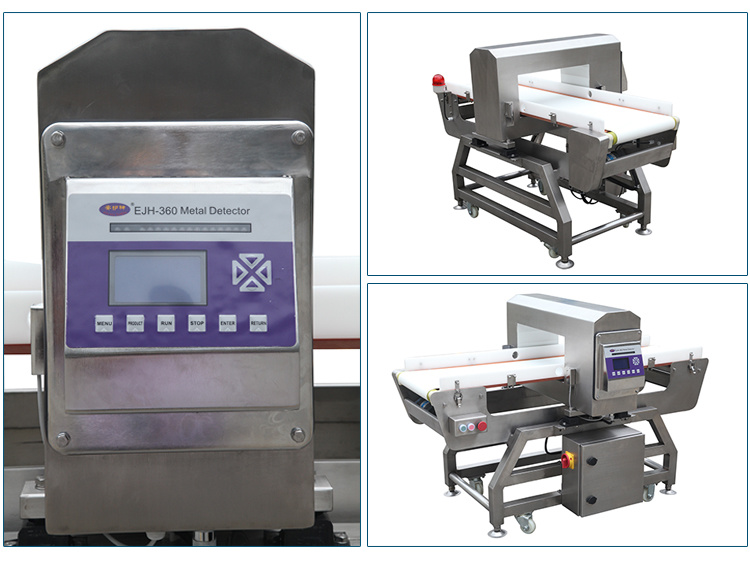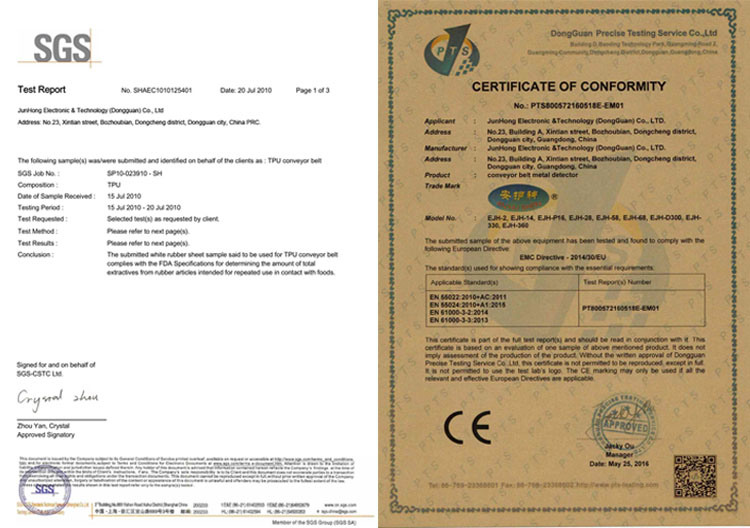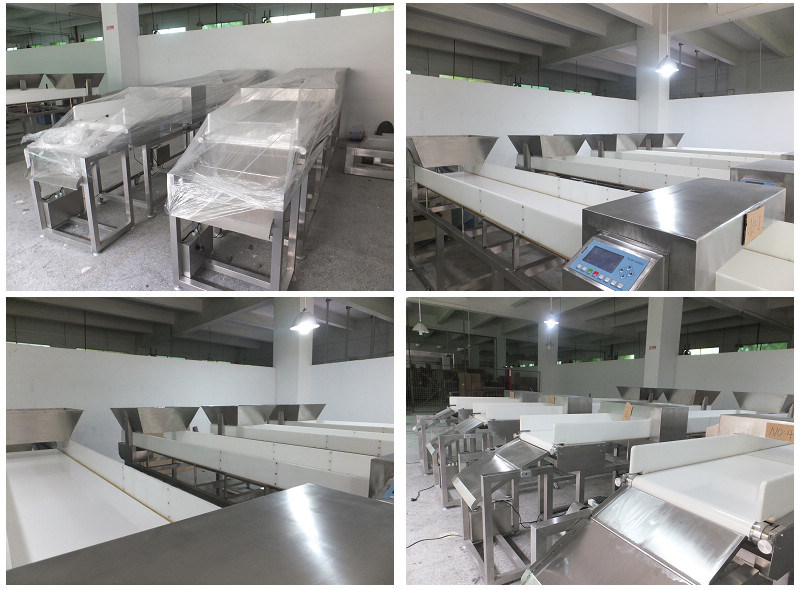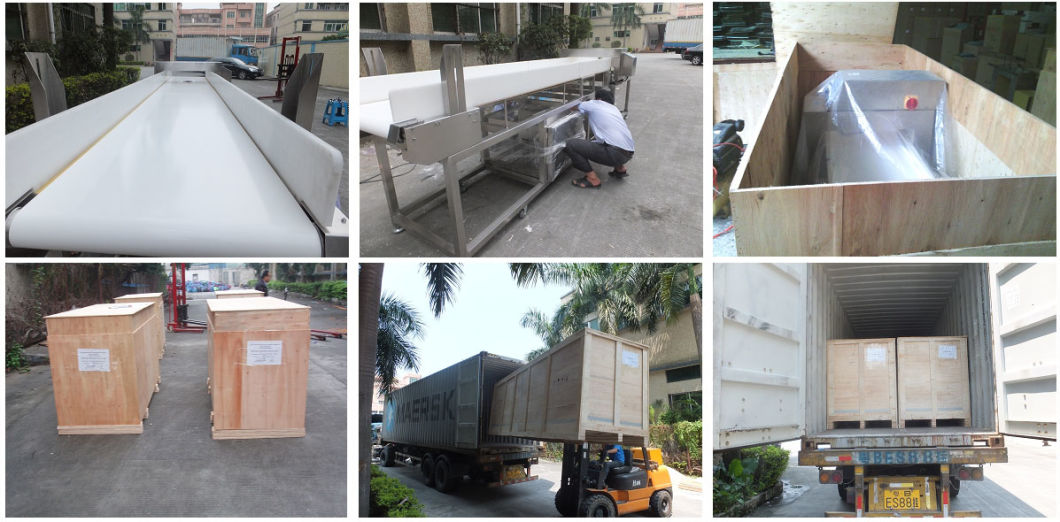High Sensitive Conveyor Belt Type Metal Detector for Foods
Model NO.: EJH-360
Type: Conveyor Belt Type Metal Detector
Detection Opening/Aperture Size: 40X15cm,40X18cm,50X20cm,50X25cm....
Grade: Food Grade Metal Detectors
Technology: DSP,Fpga
Main Material: SUS304,SUS201,PVC/PU Belt
Capacity: Bearing 25 to 50kg Products
Detects Particles: All Metals Ferrous(Iron),SUS, Al,Cu
Language: English/Spanish
Trademark: ANHUSHEN
Transport Package: Polywood Case
Specification: Metal Detector for Food
Origin: Made in China
HS Code: 8543709100
Model NO.: EJH-360
Type: Conveyor Belt Type Metal Detector
Detection Opening/Aperture Size: 40X15cm,40X18cm,50X20cm,50X25cm....
Grade: Food Grade Metal Detectors
Technology: DSP,Fpga
Main Material: SUS304,SUS201,PVC/PU Belt
Capacity: Bearing 25 to 50kg Products
Detects Particles: All Metals Ferrous(Iron),SUS, Al,Cu
Language: English/Spanish
Trademark: ANHUSHEN
Transport Package: Polywood Case
Specification: Metal Detector for Food
Origin: Made in China
HS Code: 8543709100
High Sensitive Conveyor Belt Type Metal Detector for Foods

Â
Â
In the food production industry, metal is one of the most commonly found contaminant materials in food. Metal can be introduced at all stages of processing of food, as it is most commonly used in the construction of machinery, handling equipment and ancillary utensils. A metal detector for the food industry can help ensure the safety and integrity of a wide range of unpackaged, packaged or bulk goods, by identifying metal contaminants during processing or packaging and helping to ensure that they do not enter food that we eat. As part of a HACCP program, metal detection systems can be utilised to provide compliance with food safety standards, retailers' code of practice, legislation and industry guidance.Â
Types of Contaminants
There are three main groups of metallic contaminants that a food metal detector can sense:
Ferrous
Non Ferrous
Stainless Steel detection depends on the magnetic or conductive properties of the contaminant
Â
The ability for a conventional metal detector used in the food industry to detect metallic contaminants depends upon their conductivity and magnetic permeability:
Ferrous metal contaminants are both magnetic and conductive and are easily detected.
Although they are not magnetic, Non-Ferrous contaminants are good conductors and can be detected relatively easily.
Stainless Steel foreign bodies are the most difficult to pick-up as they are usually non-magnetic and a poor electrical conductor. The ability to detect stainless steel is also hindered when the product is wet or has a high salt content.
Â
If there are other types of contaminants (glass, calcified bone, ceramics, stone) to be detected, then an X-ray inspection system for food will offer enhanced detection capabilities.
Features:
- Phase tracking function, which can maintain the stable high-sensitivity detection ability.
- Product tracking function, which can do adjustment and compensation according to the changes of the product effect automatically.
- Auto-balanced calibration function, which can ensure the service life of the machine.
- Applying high functional FPGA, plan with Single Chip Machine.
- Above 52 products can be restored in product database.
- IP66 dust and water proof.
- The performance of the conveyor belt is complied with the American food sanitation standard (FDA), it can be used for inspection of the unpacked food directly.
- Can stably work for a long time, with a special design that is suitable for a harsh production environment of strong vibration and high interference, the equipment won't miss alarm even when you tap the probe.
Material: 304 type stainless steel for detector, 201 type stainless steel for frame, PVC/ PU white belt.
Belt length (mm): 1500mm.
Conveyor height from belt to ground 750mm + 100mm feet adjuatable, with wheels moveable.
Alarm: buzzer / warning lights.
Rejection system:
- Stop on Detect Reject(<=50KG) - The conveyor system stops if metal is detected and an alarm sounds, enabling the operator to remove the contaminated product.
- Pusher Reject(<=10KG) - Pneumatically powered pushers divert contaminated product out of the production flow/ belt, see below picture.
- Flap Reject - End Flap/Lift Flap reject mechanism are typically used to remove contaminated and/or out of spec dry bulk products. Product passes through a chute which in the open position allows good product to continue through. The end flap or lift flap is triggered to divert contaminated or out of spec product out of the good product flow.
Flow direction: from left to right or opposite(facing control panel).
Language for operation system: English/Spanish.
Electronic source: AC110V/220V, 50/60Hz, power: 90/120/200W.
Â
Aperture/ Opening inner size & Sensitivity ability:
| Opening Width | 40 | 40 | 50 | 50 | 50 | 60 |
| Opening Height | 15 | 18 | 15 | 20 | 25 | 30 |
| Ferrous | Φ0.8mm | Φ0.8mm | Φ0.8mm | Φ1.0mm | Φ1.2mm | Φ1.5mm |
| Non Ferrous | Φ1.0mm | Φ1.5mm | Φ1.2mm | Φ1.5mm | Φ1.8mm | Φ2.0mm |
| Stainless steel(304) | Φ1.5mm | Φ2.0mm | Φ2.0mm | Φ 2.0mm | Φ2.5mm | Φ3.0mm |
Remark: the above data is empty-loaded machine sensitivity. The real sensitivity will be lower on condition of different products being tested.
Â



Â

High Sensitive Conveyor Belt Type Metal Detector for Foods

Â
Â
In the food production industry, metal is one of the most commonly found contaminant materials in food. Metal can be introduced at all stages of processing of food, as it is most commonly used in the construction of machinery, handling equipment and ancillary utensils. A metal detector for the food industry can help ensure the safety and integrity of a wide range of unpackaged, packaged or bulk goods, by identifying metal contaminants during processing or packaging and helping to ensure that they do not enter food that we eat. As part of a HACCP program, metal detection systems can be utilised to provide compliance with food safety standards, retailers' code of practice, legislation and industry guidance.Â
Types of Contaminants
There are three main groups of metallic contaminants that a food metal detector can sense:
Ferrous
Non Ferrous
Stainless Steel detection depends on the magnetic or conductive properties of the contaminant
Â
The ability for a conventional metal detector used in the food industry to detect metallic contaminants depends upon their conductivity and magnetic permeability:
Ferrous metal contaminants are both magnetic and conductive and are easily detected.
Although they are not magnetic, Non-Ferrous contaminants are good conductors and can be detected relatively easily.
Stainless Steel foreign bodies are the most difficult to pick-up as they are usually non-magnetic and a poor electrical conductor. The ability to detect stainless steel is also hindered when the product is wet or has a high salt content.
Â
If there are other types of contaminants (glass, calcified bone, ceramics, stone) to be detected, then an X-ray inspection system for food will offer enhanced detection capabilities.
Features:
- Phase tracking function, which can maintain the stable high-sensitivity detection ability.
- Product tracking function, which can do adjustment and compensation according to the changes of the product effect automatically.
- Auto-balanced calibration function, which can ensure the service life of the machine.
- Applying high functional FPGA, plan with Single Chip Machine.
- Above 52 products can be restored in product database.
- IP66 dust and water proof.
- The performance of the conveyor belt is complied with the American food sanitation standard (FDA), it can be used for inspection of the unpacked food directly.
- Can stably work for a long time, with a special design that is suitable for a harsh production environment of strong vibration and high interference, the equipment won't miss alarm even when you tap the probe.
Material: 304 type stainless steel for detector, 201 type stainless steel for frame, PVC/ PU white belt.
Belt length (mm): 1500mm.
Conveyor height from belt to ground 750mm + 100mm feet adjuatable, with wheels moveable.
Alarm: buzzer / warning lights.
Rejection system:
- Stop on Detect Reject(<=50KG) - The conveyor system stops if metal is detected and an alarm sounds, enabling the operator to remove the contaminated product.
- Pusher Reject(<=10KG) - Pneumatically powered pushers divert contaminated product out of the production flow/ belt, see below picture.
- Flap Reject - End Flap/Lift Flap reject mechanism are typically used to remove contaminated and/or out of spec dry bulk products. Product passes through a chute which in the open position allows good product to continue through. The end flap or lift flap is triggered to divert contaminated or out of spec product out of the good product flow.
Flow direction: from left to right or opposite(facing control panel).
Language for operation system: English/Spanish.
Electronic source: AC110V/220V, 50/60Hz, power: 90/120/200W.
Â
Aperture/ Opening inner size & Sensitivity ability:
| Opening Width | 40 | 40 | 50 | 50 | 50 | 60 |
| Opening Height | 15 | 18 | 15 | 20 | 25 | 30 |
| Ferrous | Φ0.8mm | Φ0.8mm | Φ0.8mm | Φ1.0mm | Φ1.2mm | Φ1.5mm |
| Non Ferrous | Φ1.0mm | Φ1.5mm | Φ1.2mm | Φ1.5mm | Φ1.8mm | Φ2.0mm |
| Stainless steel(304) | Φ1.5mm | Φ2.0mm | Φ2.0mm | Φ 2.0mm | Φ2.5mm | Φ3.0mm |
Remark: the above data is empty-loaded machine sensitivity. The real sensitivity will be lower on condition of different products being tested.
Â



Â

Data Industry Co.,Ltd , https://www.whdatacn.com